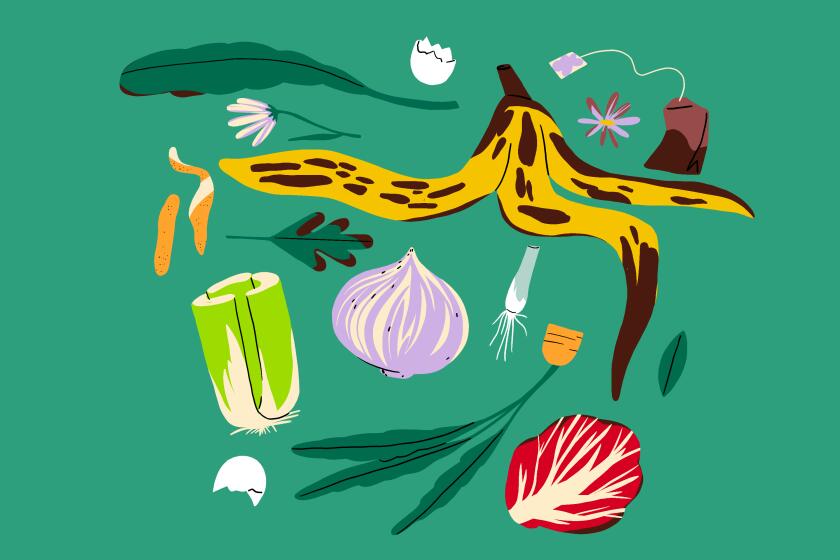Why fall gardens need compost and amendments

- Share via
So you likely spent a bundle on preparing your first victory garden last spring, with organic potting soils, compost and manures. Why should you have to go out to buy more for your cool-weather garden this fall?
Because the veggies you planted last spring devoured those beneficial microbes, said master gardener Yvonne Savio, creator of GardeningInLA.net, and your depleted soil needs another jolt to feed the greens and other goodies you want to grow this fall.
“The plants you grew this summer sucked up the energy and nutrition you put in your soil, just like it sucked up the moisture you put in the ground,” Savio said. “It’s like asking, ‘I ate dinner last Sunday. Why should I have dinner again this Sunday?’”
Like most garden experts, Savio preaches the benefits of feeding your soil, not your plants. In other words, forget about fertilizers and concentrate on building a healthy, nutrient-rich soil.
Bottom line: When a new season comes along, you need to invest in good soil amendments to make sure your other investments in plants and time don’t go to waste.
Amendments not only add beneficial microorganisms to the soil, Savio said, but keep it loose and well drained, an important consideration during the winter when heavy rains can make soils soggy and drown your plants.
It’s time to stop wringing your hands over COVID-19: Plant some food and create your own victory garden. Here are eight steps to get started.
Here are six steps for preparing the soil for your fall garden: 1. Out with the old
Pull out your tired old summer plants and clean up any old mulch or plant debris (put it in your compost pile unless it’s harboring disease or a serious insect infestation). Removing that plant litter will discourage pests and diseases from wintering in your garden to attack future crops.
2. Feed the soil
For every 8-by-4-foot garden space or raised bed, Savio recommends the following amendment recipe:
—A 2-cubic-foot bag of compost, if you don’t make your own. (Pro tip: Here’s a good time to start your own compost pile for the spring.)
—A 2-cubic-foot bag of aged steer manure (never fresh, since that can burn roots and potentially spread diseases). Some people prefer chicken manure because it’s more potent, Savio said, but it’s also easier to overdo with chicken manure and kill your young plants. If you must use aged chicken manure, Savio recommends using a much smaller amount, about half a cubic foot, and incorporate it well into the soil and other amendments.
—A 5-gallon container of used coffee grounds and/or tea leaves for an extra shot of nitrogen. Savio provides 5-gallon buckets to her local coffeeshops and trades them out weekly to add to her garden soil. (Don’t worry if your stash includes used coffee filters or tea bags; those can decompose in the compost pile.)
More on fall planting
3. Grab a fork
Layer the amendments on the soil and mix them in using a garden fork or spade. (Pro tip: Forks are much better at mixing amendments into the soil, easier on your back and an indispensable tool for turning your compost pile.) 4. Stand down
Once you thoroughly mix in your organic amendments, take a breather and let the newly enriched soil sit for a week or two. This is important, Savio said, because the microbes will start heating up the soil as they decompose, much the way a compost pile heats up as its ingredients (kitchen scraps, leaves, grass clippings and other organic matter) break down. 5. Take the temperature
Put your hand in the freshly amended soil after a few days and it will feel uncomfortably hot — a heat that can spell D-E-A-T-H to seeds and young transplants (which probably weren’t cheap, not to mention the time it took you to put them in the ground).
How to make compost and (help) save the world.
6. Get planting
Once the soil feels comfortable to your hand it’s likely OK for your plants. After they’re planted, cover the soil with 3 or 4 inches of mulch, such as straw or fallen leaves, to keep warmth and moisture in the soil and break down as further food for the soil.
Amendments are worth their weight in a healthy fall and winter crop of greens, broccoli, potatoes and berries. And they’ll pay dividends going forward by giving your garden a more crumbly, loamy soil — the kind any plant would be happy to call home.
More to Read
Sign up for The Wild
We’ll help you find the best places to hike, bike and run, as well as the perfect silent spots for meditation and yoga.
You may occasionally receive promotional content from the Los Angeles Times.
















